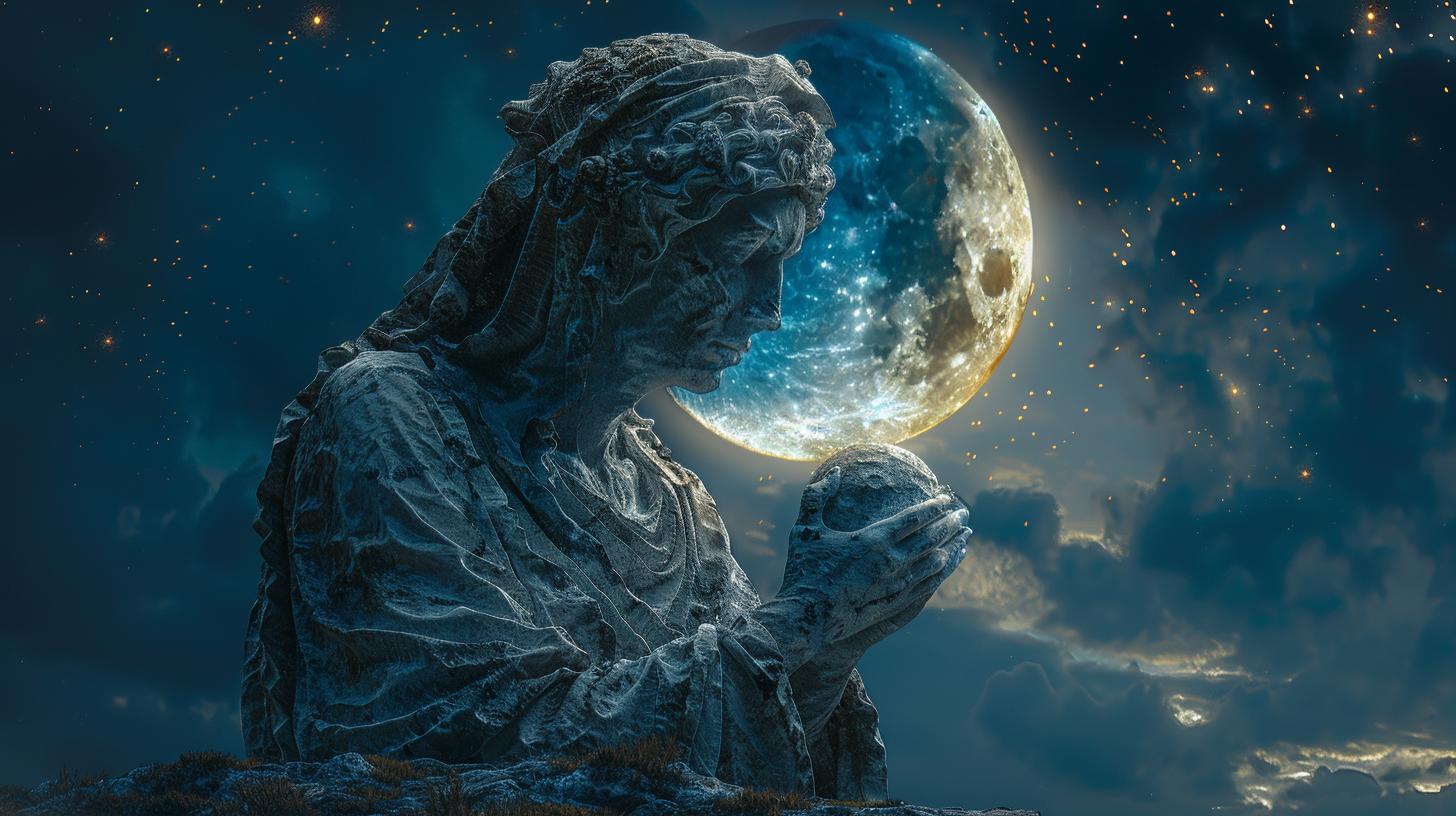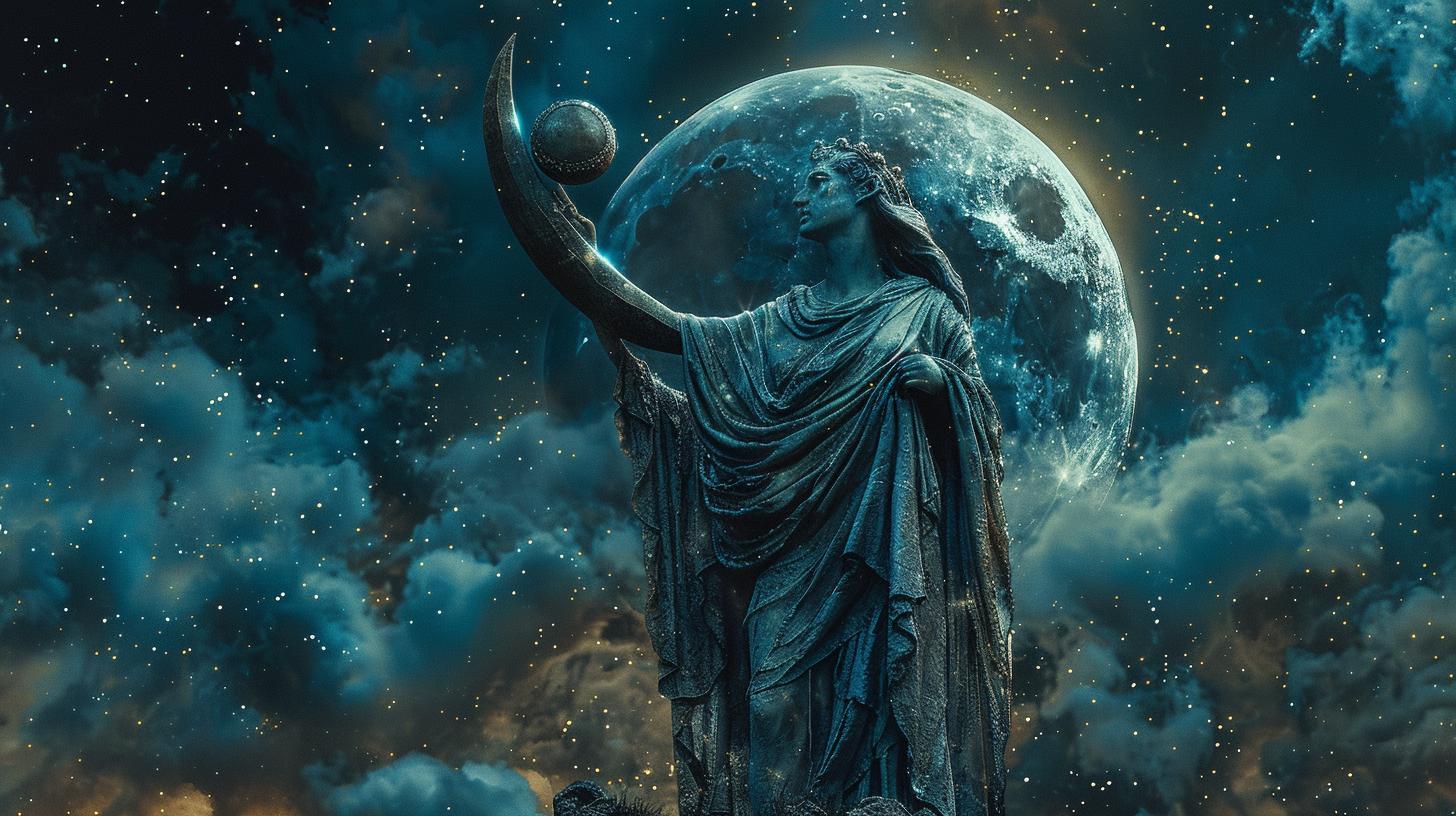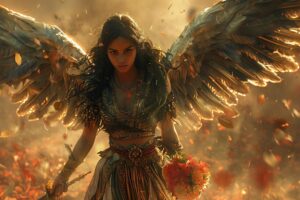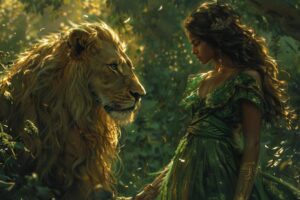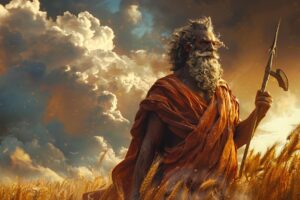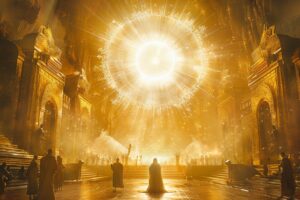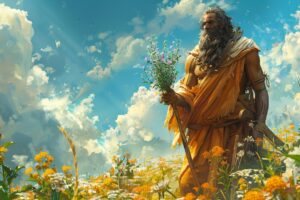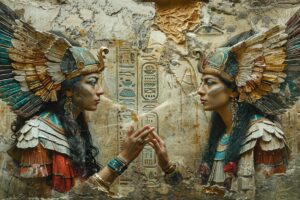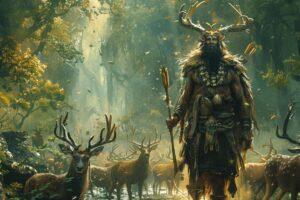Kaskuh God: Myths, Symbolism, and Cultural Influence
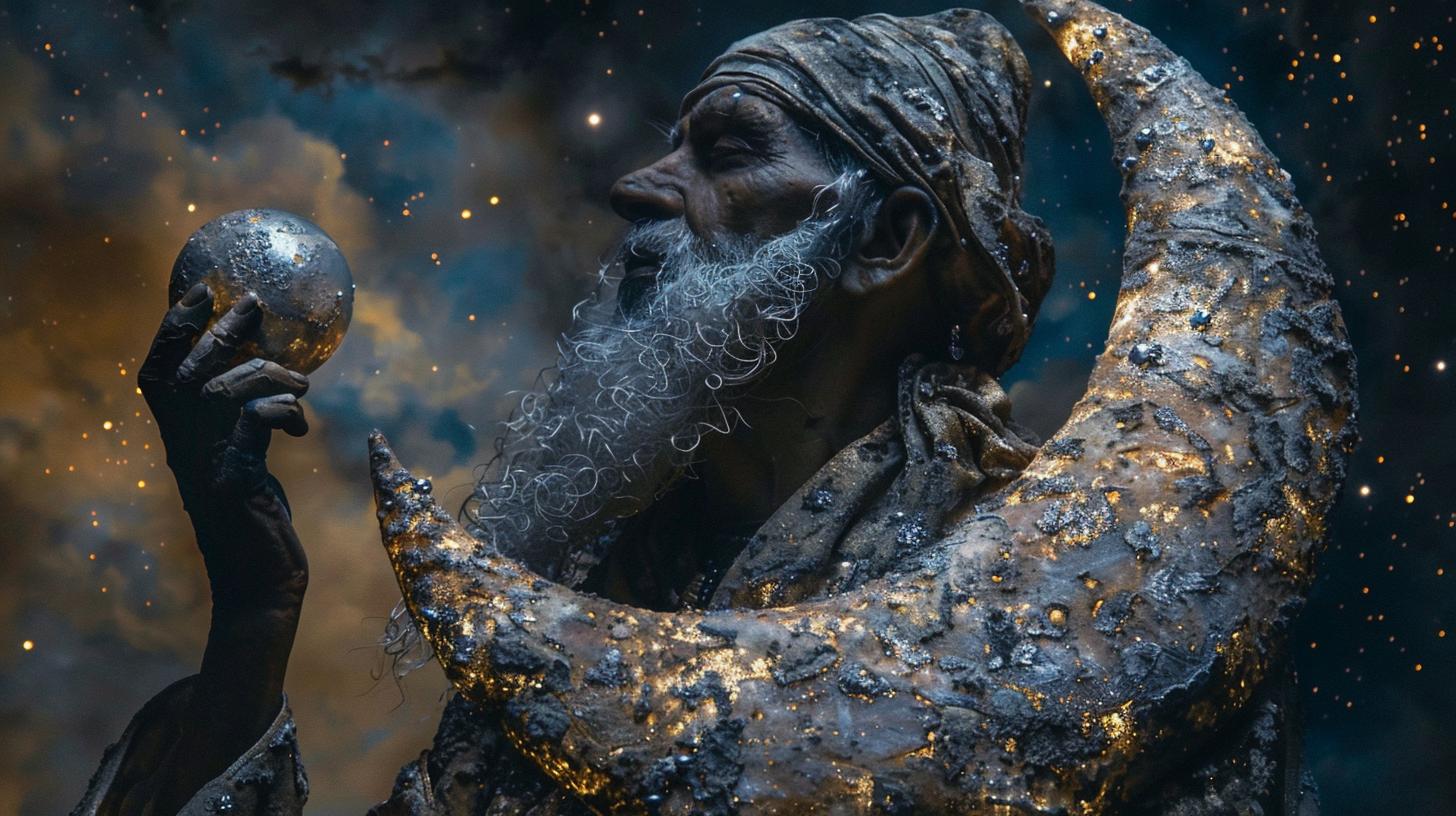
Kaskuh, known as Kašku in Hattian and Kušuḫ in Hurrian, is a prominent lunar deity in ancient Anatolian mythology. This god was central to the religious practices of the Hatti, Hurrians, and Luwians.
Kaskuh’s myths, symbolism, and rituals reflect the cultural and geographical diversity of these ancient civilizations. Various myths, roles, and iconography associated with Kaskuh highlight the god’s importance in both religious and social contexts.
Overview of Kaskuh
Kaskuh, an ancient lunar deity, is a significant figure in the mythologies of the Hatti, Hurrian, and Luwian cultures.
Origin and Etymology of Kaskuh
The origin of the name Kaskuh can be traced back to various ancient Anatolian and Mesopotamian civilizations. In the Hattian language, the name Kašku translates to ‘bright star’, emphasizing Kaskuh’s celestial nature.
In Hurrian mythology, the god is known as Kušuḫ, while in Luwian traditions, the name Arma is used. This etymological variation illustrates the god’s widespread veneration and the integration of linguistic influences.
Geographic Spread of Kaskuh Worship
The worship of Kaskuh was not confined to a single region but spanned across ancient Anatolia and Mesopotamia. Evidence from archaeological sites and ancient texts indicates that Kaskuh was venerated in numerous locations including:
- Hattusa
- Ugarit
- Alalakh
- Mari
- Nuzi
These widespread references underscore the deity’s significance and the cultural exchanges that occurred between these ancient civilizations.
Variants and Synonyms of Kaskuh
Kašku in Hattian Mythology
In the Hattian tradition, Kaskuh is predominantly known as Kašku. This variant highlights the god’s role as the moon deity and connects directly to the Hattian myths surrounding him.
Kušuḫ in Hurrian Mythology
In Hurrian mythology, Kaskuh is referred to as Kušuḫ.
The Hurrians’ reverence for this lunar deity is evident in various texts, and Kušuḫ’s attributes often reflect the syncretism with Mesopotamian lunar gods.
Arma in Luwian Mythology
In the Luwian context, Kaskuh is known as Arma. This designation illustrates the deity’s continuity and adaptation across different cultures within the ancient Anatolian and Mesopotamian worlds.
Kaskuh in Hattian Mythology
Kaskuh plays a significant role in Hattian mythology, especially as the god of the moon.
Role as the Moon God
Kaskuh, in the Hattian pantheon, held the esteemed position of the moon god. He was integral to various myths and rituals, symbolizing not only the celestial body but also embodying characteristics such as brightness and nocturnal guidance.
His presence was crucial in Hattian religious practices.
The Myth of the Moon’s Fall
One of the most prominent myths involving Kaskuh is the tale of the moon’s fall, which greatly illustrates his impact on the heavenly and earthly domains.
Kašku’s Descent from Heaven
In this myth, Kašku falls from the sky and lands in the bustling market of the city of Laḫzan. This descent from the heavens is not just a physical fall but a significant cosmic event that resonates deeply within the Hattian mythology.
Anger of the Weather God Taru
Kašku’s unexpected arrival enrages the weather god, Taru. In his fury, Taru unleashes a powerful storm, drenching Kašku with relentless rain and battering him with fierce winds. This divine reaction underscores the volatile nature of the gods and their interactions.
Role of Goddess Kataḫziwuri and Ḫapantali
Witnessing Kašku’s plight, the goddess Kataḫziwuri, along with Ḫapantali, steps in to perform a ritual to appease Taru. Their intervention highlights the interconnectedness of the divine beings and the importance of rituals in restoring balance and harmony among the gods.
Ritual Practices Involving Kašku
The myth of Kašku’s fall is not merely a story but also serves as a foundational narrative for ritual practices dedicated to the moon god. These rituals were performed to calm the wrathful weather god and ensure celestial stability.
They were integral to Hattian religious life, binding the community through shared acts of worship and appeasement.
Kušuḫ in Hurrian Mythology
Kušuḫ, the Hurrian counterpart of the lunar deity, plays a significant role within Hurrian religious beliefs and practices.
Attributes and Symbolism of Kušuḫ
Kušuḫ is often depicted with symbols that emphasize his lunar nature. Common representations include a crescent moon crown and occasionally wings. As a moon god, his role extends into the realms of oracles and fate.
Key Myths Involving Kušuḫ
Alliances with Teššub in the Kumarbi Cycle
In Hurrian mythology, Kušuḫ is closely allied with the weather god Teššub. Together, they confront the god Kumarbi in a series of narratives known as the Kumarbi Cycle. These myths often highlight the cooperation among gods to maintain cosmic order.
Role in Oracles and Jurisprudence
Kušuḫ holds a key position in oracular and judicial contexts. Known as a protector of oaths and divine judgments, his influence is evident in legal texts from Ugarit and other ancient Hurrian sites.
He is frequently invoked in rituals seeking guidance and truth.
Associations with Other Deities
The Goddess Nikkal
Kušuḫ is closely associated with the goddess Nikkal, who is often portrayed as his consort. This connection underscores his role in fertility and childbirth, reflecting the moon’s influence on human and agricultural cycles.
Parallels with Mesopotamian Sin
There are notable parallels between Kušuḫ and the Mesopotamian moon god Sin. Both deities share similar attributes and functions, leading to a blending of their iconography and worship practices in regions where Hurrian and Mesopotamian cultures intersected.
Potential Offspring and Lineage
While specific myths about Kušuḫ’s offspring are sparse, some traditions suggest links to other significant deities. Teššub is occasionally mentioned as his son, although this connection remains debated among scholars. Other possible descendants may include deities linked with lunar or chthonic aspects.
Representations in Art and Inscriptions
Kušuḫ’s depiction in art and inscriptions provides valuable insights into his worship. Artifacts from temples and ruins often feature his likeness, emphasizing his importance. Notable examples include the iconography found in the Yazılıkaya sanctuary and the golden bowl from Hasanlu.
Arma in Luwian Mythology
Arma, the Luwian counterpart of Kaskuh, is a prominent lunar deity in Luwian mythology.
Iconography of Arma
The iconography of Arma is rich and symbolically significant. The god is typically depicted with distinct features that highlight his role as a lunar deity.
- Arma is often shown with a crescent moon crown, symbolizing his association with the moon.
- Winged figures frequently represent Arma, emphasizing his celestial nature.
These artistic representations appear in various relics and carvings throughout the Luwian region, reinforcing his importance in Luwian culture.
Myths and Stories Featuring Arma
Numerous myths and stories revolve around Arma, encapsulating his significance in Luwian mythology. Among these stories, some stand out due to their impactful narratives.
- One prominent myth involves Arma’s role in controlling the lunar phases, showcasing his influence over time and celestial events.
- Another story depicts Arma’s intervention in a great battle, where his guidance helped secure victory for the Luwian people.
Cultural Significance of Arma
Arma held a vital role in the cultural and religious practices of the Luwians.
He was revered not only for his lunar associations but also for his protective qualities.
Rituals dedicated to Arma often coincided with key lunar phases and agricultural cycles, illustrating his deep connection to both celestial and terrestrial aspects of Luwian life.
Ultimately, Arma’s widespread veneration underscores his integral place in Luwian spirituality and daily existence.
Symbolism and Iconography
The symbolism and iconography associated with Kaskuh, also known as Kašku or Kušuḫ, reveal the cultural and religious significance attributed to lunar deities in ancient Anatolian civilizations.
Common Symbols Associated with Kaskuh
The Winged Figure
One of the most prominent symbols linked to Kaskuh is the winged figure. This representation typically features Kaskuh with extended wings, symbolizing his celestial nature and his role as a deity connected to the skies.
These depictions were common in Hittite and Hurrian art, emphasizing his divine authority and omnipresence.
The Crescent Moon Crown
Another significant iconographic element is the crescent moon crown. Kaskuh is often portrayed wearing a crown adorned with a crescent moon, a direct reference to his identity as the lunar god.
This crown not only highlights his dominion over the moon but also serves as a recognizable attribute that distinguishes him from other deities.
Depictions in Temples and Artifacts
Yazılıkaya Sanctuary Figures
The Yazılıkaya sanctuary provides some of the most detailed depictions of Kaskuh. In this iconic site, various carvings and reliefs illustrate Kaskuh in his traditional iconography, complete with wings and a crescent moon crown.
These figures play an essential role in understanding how ancient worshippers visualized and venerated this deity.
The Golden Bowl of Hasanlu
The golden bowl from Hasanlu offers another significant artifact that features a depiction of a lunar god, likely Kaskuh. In this artifact, the god is shown being transported in a chariot pulled by mules, which is a scene that signifies his high status and celestial journey.
The artistic style suggests Hurrian influence, underlining the interconnectedness of different cultures in the ancient Near East.
Rituals and Worship Practices
The worship of Kaskuh involves various rituals and practices that underscore its significance in ancient cultures.
Key Rituals for the Moon God
The rituals dedicated to the Moon God varied among the Hatti, Hurrian, and Luwian cultures. These practices often included:
- Offerings and sacrifices to honor the lunar deity
- Nights of vigil where worshippers stayed up to watch the moon
- Special chants and prayers invoking the protection and blessings of Kaskuh
Some rituals were performed to ensure favorable weather, bountiful harvests, and to seek guidance from the celestial body.
Seasonal and Astronomical Significance
The lunar cycle influenced several cultural observances. Festivals and rituals were often timed with key phases of the moon:
- New Moon ceremonies marked the beginning of a new lunar cycle
- Full Moon celebrations were held to harness the peak of lunar energy
- Eclipse rituals aimed to protect the community from potential negative outcomes
Astronomical events such as solstices and equinoxes also factored into the worship practices associated with Kaskuh.
Influence on Later Lunar Deities
The worship practices for Kaskuh had a lasting impact on subsequent lunar deities. The rituals spread across regions and influenced various cultures.
Spread to Ugarit and Elsewhere
The syncretism of lunar worship led to the spread of Kaskuh’s influence to Ugarit and other regions. This spread is evidenced in the adaptation of lunar deities in surrounding cultures:
- The god Yarikh in Ugaritic religion displays similarities to Kaskuh
- Ritual practices in Ugarit incorporated elements from those dedicated to Kaskuh
- Iconography and symbols of Kaskuh influenced the visual representations of later deities
This cultural exchange illustrates the interconnectedness of ancient civilizations in their religious practices.
Kaskuh’s Influence on Other Lunar Deities
Kaskuh’s legacy extended beyond his immediate geographical and cultural context, affecting various lunar deities in Mesopotamia and surrounding regions.
Syncretism with Mesopotamian Deities
Connection to Sin
The Mesopotamian moon god, Sin, shares numerous attributes with Kaskuh. This connection is evident through similarities in iconography, rituals, and attributes. Sin’s role as the overseer of time, calendars, and oaths paralleled the responsibilities held by Kaskuh.
The connection between these two deities is significant as it showcases the cultural and religious exchanges between Anatolia and Mesopotamia.
Impact on Yarikh and Others
Yarikh, the lunar god of Ugarit, reflects Kaskuh’s influence in his iconography and mythological narratives. Yarikh is depicted with a lunar disk and crescent, similar to Kaskuh’s representations. Furthermore, the rituals and practices dedicated to Yarikh show parallels to those observed in Kaskuh worship, demonstrating how Kaskuh’s legacy permeated into Ugaritic culture.
Other deities, like the lunar figures in Mari and Nuzi, also exhibit traits that can be traced back to Kaskuh’s iconography and worship practices.
Legacy in Anatolian and Mesopotamian Regions
Kaskuh’s impact on lunar worship practices and deities can be seen across Anatolia and Mesopotamia through the adoption and adaptation of his rituals and symbols. His influence is evident in:
- The incorporation of lunar crescents and disks in religious artifacts.
- The alignment of lunar deities’ roles with Kaskuh’s responsibilities.
- The syncretism observed in mythological narratives and deific hierarchies.
These cumulative influences show how Kaskuh’s worship not only shaped lunar worship traditions in his origin culture but also left an indelible mark on neighboring civilizations.
The blending of religious symbols and stories highlights the cultural exchanges that were prevalent in the ancient world, further cementing Kaskuh’s role in the broader pantheon of lunar deities.

